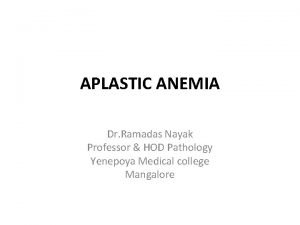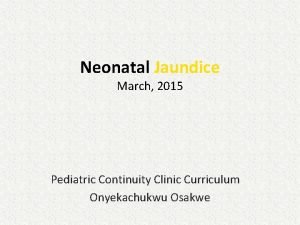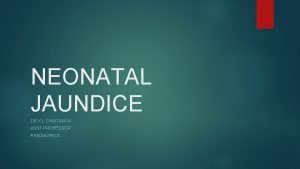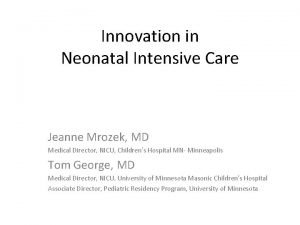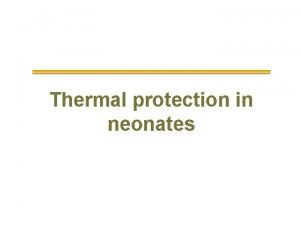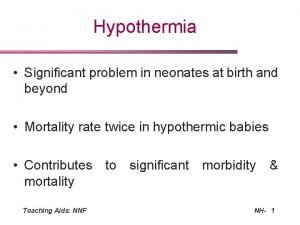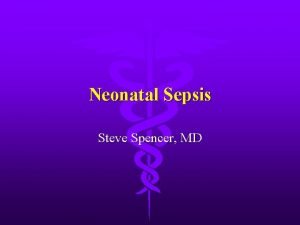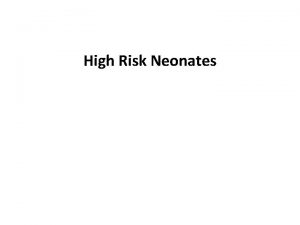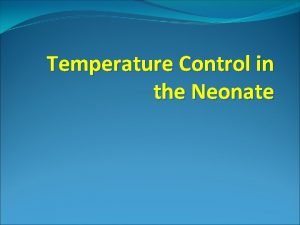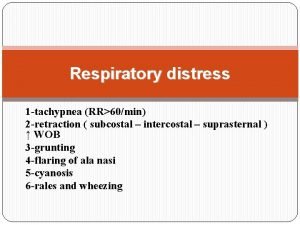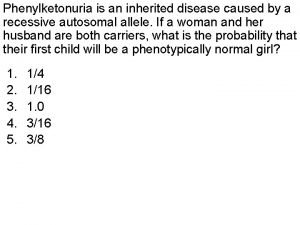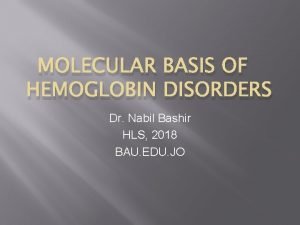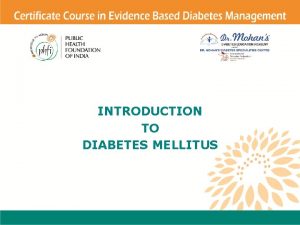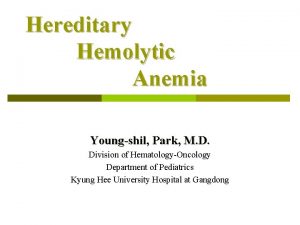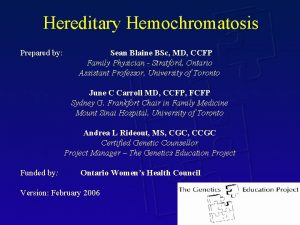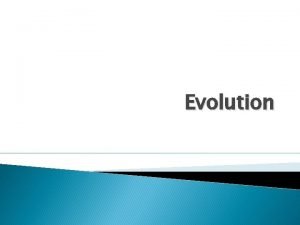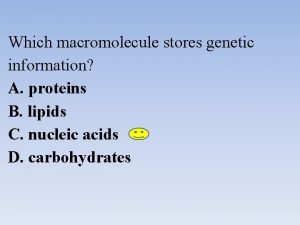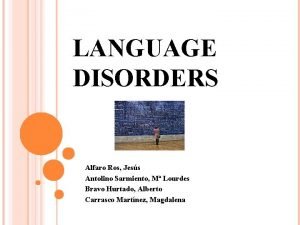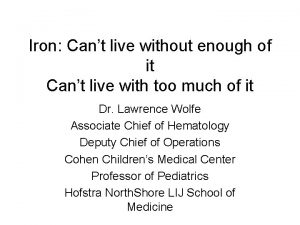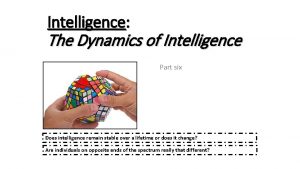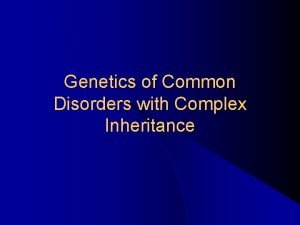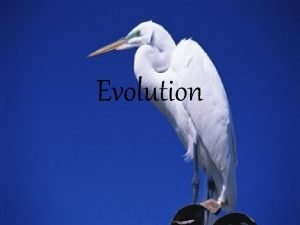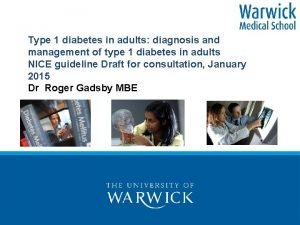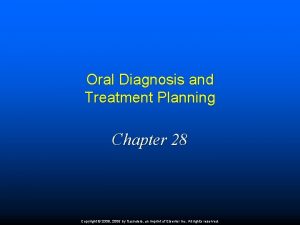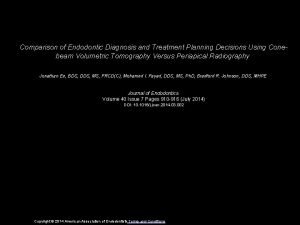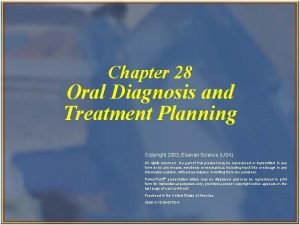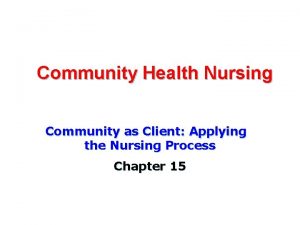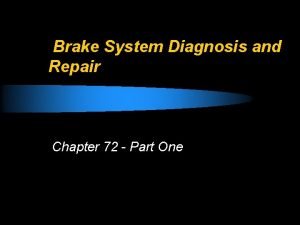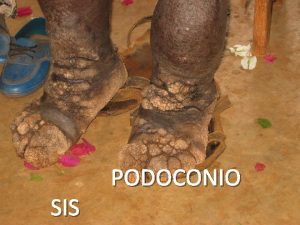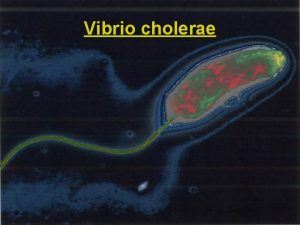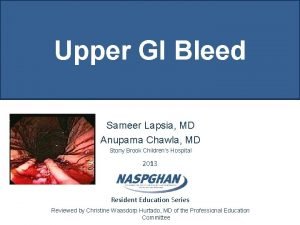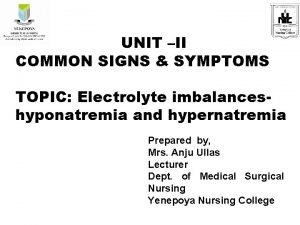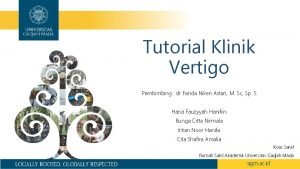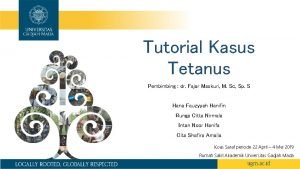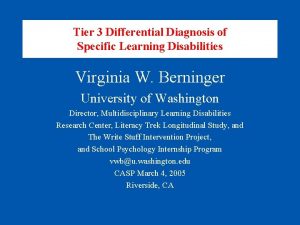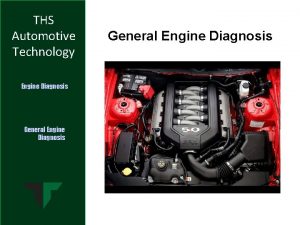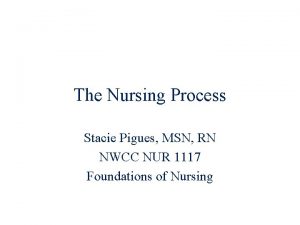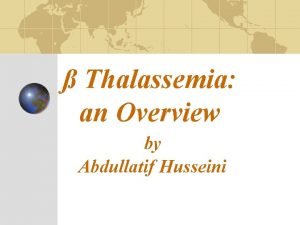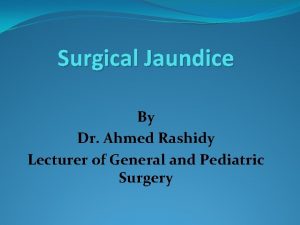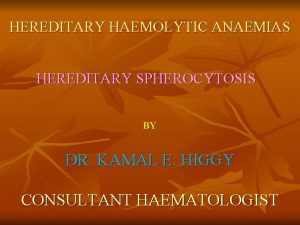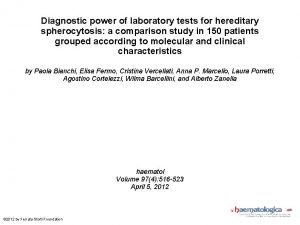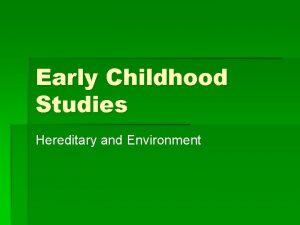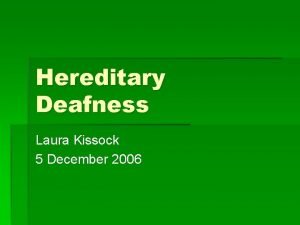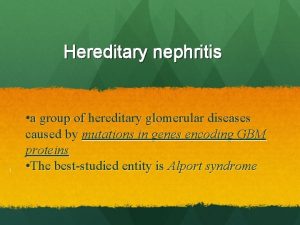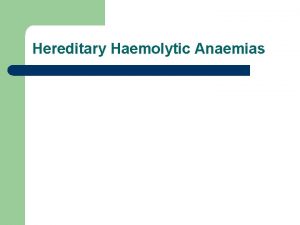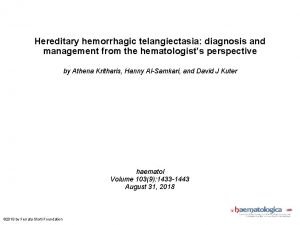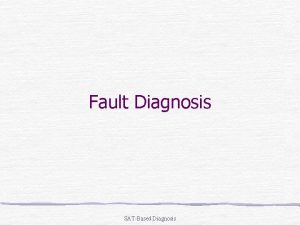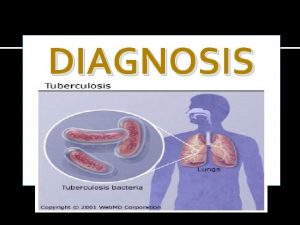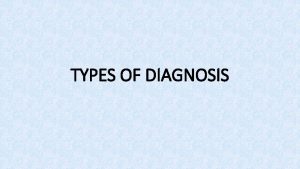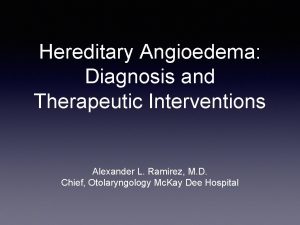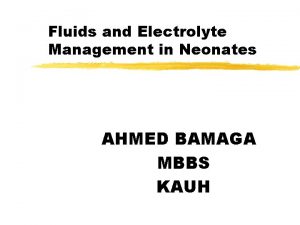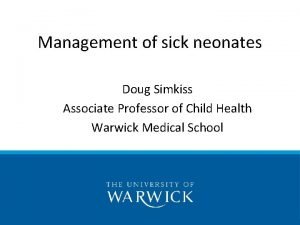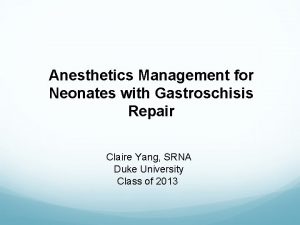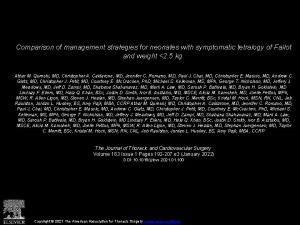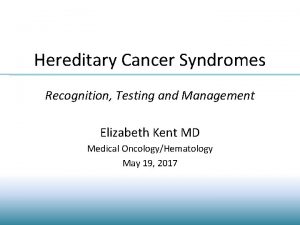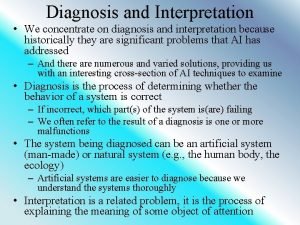Diagnosis and Management of Hereditary Spherocytosis in Neonates

































































- Slides: 65

Diagnosis and Management of Hereditary Spherocytosis in Neonates Israel Neonatology Association Robert Christensen, MD

Hereditary Spherocytosis • A heterogeneous disorder where abnormalities of RBC structural proteins lead to loss of RBC membrane surface area. • Spherical-shaped, hyperdense, poorly deformable red cells with a shortened life span. • Occurs world-wide & affects all racial and ethnic groups. • A common genetic cause of extreme neonatal jaundice.

STATE-OF-THE-ART REVIEW ARTICLE A Pediatrician’s Practical Guide to Diagnosing and Treating Hereditary Spherocytosis in Neonates Robert D. Christensen, Hassan M. Yaish, and Patrick G. Gallagher 2015

Large Fresh Water Lake The River Jordan Dead Sea


Outline 1. Hereditary Spherocytosis in Israel 2. Pathogenesis & responsible mutations 3. Making the diagnosis in the Newborn Nursery or NICU 4. Natural history during the neonatal period 5. Treatment

Outline 1. Hereditary Spherocytosis in Israel 2. Pathogenesis & responsible mutations 3. Making the diagnosis in the Newborn Nursery or NICU 4. Natural history during the neonatal period 5. Treatment

Ballin A, Waisbourd-Zinman O, Saab H, Yacobovich J et al. Steroid therapy may be effective in augmenting hemoglobin levels during hemolytic crises in children with hereditary spherocytosis. Pediatr Blood Cancer. 2011 Aug; 57(2): 303 -5 Department of Pediatrics, Edith Wolfson Medical Center, Holon, Israel. 118 children with Hereditary Spherocytosis cared for at Edith Wolfson Medical Center.

Streichman S, Gescheidt Y. Cryohemolysis for the detection of hereditary spherocytosis: correlation studies with osmotic fragility and autohemolysis. American J. Hematology 1998 Jul; 58(3): 206 -12. Department of Hematology, Rambam Medical Center, Haifa, Israel. Developed a diagnostic test based on a unique sensitivity of HS cells to hypertonic cryohemolysis and analyzed blood samples of 55 HS patients.

Tamary H, Aviner S, Freud E, et al. High incidence of early cholelithiasis detected by ultrasonography in children and young adults with hereditary spherocytosis. J Pediatr Hematol/Oncol 2003 Dec; 25(12): 952 -4. Department of Hematology-Oncology, Schneider Children's Medical Center of Israel, Petah Tikva. 41% of patients with HS (18/44) developed cholelithiasis as demonstrated by gallbladder ultrasonography. In most patients (94%) the test first proved positive at age 4 to 13 years. Patients with HS and Gilbert syndrome tended to be younger at the time of cholelithiasis.

Did these children with HS have the typical course of severe neonatal jaundice? How many are autosomal dominant? Which mutations? How many are autosomal recessive varieties or de novo mutations? Would there be value in identifying these as newborns and providing anticipatory guidance regarding development of jaundice, anemia, gall bladder disease?

Outline 1. Hereditary Spherocytosis in Israel 2. Pathogenesis & responsible mutations 3. Making the diagnosis in the Newborn Nursery or NICU 4. Natural history during the neonatal period 5. Treatment

HEREDITARY SPHEROCYTOSIS Spherocyte Prevalence in the Utah, USA = 1/1000

Red Blood Cell Membrane Proteins

Protein Gene Chromosomal location Percent of HS cases Typical severity Inheritance Ankyrin-1 ANK 1 8 p 11. 2 40 -50% Mild to moderate Autosomal dominant Band 3 SLC 4 A 1 17 q 21 20 -35% Mild to moderate Autosomal dominant Beta Spectrin SPTB 14 q 23 -24. 1 15 -30% Mild to moderate Autosomal dominant Alpha Spectrin SPTA 1 1 q 22 -23 <5% Severe Autosomal recessive Protein 4. 2 EPB 42 15 q 15 -21 <5% Mild to moderate Autosomal recessive

Outline 1. Hereditary Spherocytosis in Israel 2. Pathogenesis & responsible mutations 3. Making the diagnosis in the Newborn Nursery or NICU 4. Natural history during the neonatal period 5. Treatment

Making the Diagnosis in a Neonate • First step in making the diagnosis of HS is considering it in the differential diagnosis.

Making the Diagnosis in a Neonate • First step in making the diagnosis of HS is considering it in the differential diagnosis. • The triad of anemia, splenomegaly, and jaundice, found in older children and adults with HS, is rare in neonates.

Making the Diagnosis in a Neonate • First step in making the diagnosis of HS is considering it in the differential diagnosis. • The triad of anemia, splenomegaly, and jaundice, found in older children and adults with HS, is rare in neonates. • Most neonates with HS are not anemic in the first week of life.

Making the Diagnosis in a Neonate • First step in making the diagnosis of HS is considering it in the differential diagnosis. • The triad of anemia, splenomegaly, and jaundice, found in older children and adults with HS, is rare in neonates. • Most neonates with HS are not anemic in the first week of life. • Jaundice is the most common presenting feature of HS in neonates.

Making the Diagnosis in a Neonate • First step in making the diagnosis of HS is considering it in the differential diagnosis. • The triad of anemia, splenomegaly, and jaundice, found in older children and adults with HS, is rare in neonates. • Most neonates with HS are not anemic in the first week of life. • Jaundice is the most common presenting feature of HS in neonates. • The typically sluggish erythropoietic response of neonates in the first months often renders the reticulocyte count low relative to the degree of anemia.

Making the Diagnosis in a Neonate • First step in making the diagnosis of HS is considering it in the differential diagnosis. • The triad of anemia, splenomegaly, and jaundice, found in older children and adults with HS, is rare in neonates. • Most neonates with HS are not anemic in the first week of life. • Jaundice is the most common presenting feature of HS in neonates. • The typically sluggish erythropoietic response of neonates in the first months often renders the reticulocyte count low relative to the degree of anemia. • Sometimes in neonates with HS, spherocytes are not clearly discerned on the early blood smears.

Making the Diagnosis in a Neonate • 65 percent of neonates with HS have a parent with HS. • When a parent has HS it is important that this information be placed prominently in the prenatal record and communicated verbally, before birth, to the physicians and the hospital staff who will be providing neonatal care. • Failure to communicate this information sometimes occurs when the affected parent has been asymptomatic since splenectomy as a child, and has all but forgotten about the condition and fails to consider that it might be problematic for their newborn infant.

Evaluating a neonate, during the birthhospitalization, whose parent has HS ● Follow the serum bilirubin level and treat according to the AAP guidelines during and for several days after the birth hospitalization as if this were a known case of hemolysis. ● During the birth hospitalization initiate the evaluation (next slide) or as suggested by hematology consultation. ● Consider that the neonate could have more severe jaundice than the parent did as a neonate, particularly if there has been co-inheritance of a polymorphism retarding bilirubin uptake or conjugation.

A screening test for HS in neonates MCHC mean corpuscular hgb concentration (g/d. L), the concentration of hemoglobin in an erythrocyte. The MCHC is HIGH in neonates with HS. MCV mean corpuscular volume (f. L = 10 -15 L), the size of circulating erythrocytes. The MCV is LOW in neonates with HS. Dr. Maxwell M. Wintrobe

A screening test for HS in neonates MCHC mean corpuscular hgb concentration (g/d. L), the concentration of hemoglobin in an erythrocyte. The MCHC is HIGH in neonates with HS. MCHC/MCV mean corpuscular volume (f. L = 10 -15 L), the size of circulating erythrocytes. The MCV is LOW in neonates with HS. Dr. Maxwell M. Wintrobe

BLACK LINE = neonates with HS GREY LINE = neonates who do not have HS

Neonate with MCHC/MCV >0. 37 98% sensitivity 98% specificity for HS

ORIGINAL ARTICLE A Simple Screen to Detect Hereditary Spherocytosis in Jaundiced Newborn Infants RD Christensen, HM Yaish, E Henry Neonate with MCHC/MCV >0. 37 98% sensitivity 98% specificity for HS

Obtain CBC & Blood Smear High MCHC/MCV ratio (≥ 0. 37) Likely to have autosomal dominant HS ● EMA Flow ● Incubated osmotic fragility ● Hematology consultation Intermediate (0. 35 -0. 36) or Normal (<0. 35) MCHC/MCV ratio Spherocytes No Spherocytes Might have autosomal dominant HS Less likely to have autosomal dominant HS (but sometimes spherocytes are not prominent on blood films of neonates with HS)

Evaluating a neonate with “problematic jaundice” where the etiology is unclear. • Not all neonates with problematic jaundice have hemolytic jaundice. • If hemolytic jaundice is suspected, the following algorithm for step-wise evaluation of etiology might be useful.

PROBLEMATIC NEONATAL JAUNDICE? To evaluate potential underlying causes, obtain blood group on mother and baby, DAT, and CBC with peripheral blood smear DAT Positive In ABO hemolytic disease, if the jaundice is severe or atypical, consider the possibility of a co-existing condition – consider additional diagnostic testing sequencing DAT Negative RBC Enzymology or Other Intrinsic Defect G 6 PD Pyruvate Kinase Other Pathogenesis Still Unclear? ● Additional diagnostic testing ● Next generation DNA sequencing ● Hematology consultation Suspicious for HS? (MCHC/MCV >0. 37) EMA Flow or Incubated osmotic fragility

ORIGINAL ARTICLE Evaluating eosin-5 -maleimide binding as a diagnostic test for hereditary spherocytosis in newborn infants RD Christensen, AM Agarwal, RH Nussenzveig, N Heikal, MA Liew and HM Yaish • EMA-flow on the blood of 31 neonates; 20 healthy newborns and 11 suspected of HS. • The 20 healthy newborns and the 2 in whom HS was suspected but later excluded all had normal EMA-flow. • All nine in whom HS was confirmed had abnormal EMA-flow results. 2015

NEXTGEN High Through-put Gene Sequencing

Gene Symbol SPTA 1 SPTB ANK 1 SLC 4 A 1 Spectrin alpha 182860 Elliptocytosis, spherocytosis, pyropoikiolocytosis Spectrin beta 182870 Elliptocytosis, spherocytosis Ankyrin 1 612641 Spherocytosis Erythrocyte membrane protein band 3 109270 Spherocytosis, stomatocytosis, ovalocytosis EPB 41 EPB 42 PIEZO 1 Erythrocyte membrane protein band 4. 1 130500 Elliptocytosis Erythrocyte membrane protein band 4. 2 177070 Spherocytosis Piezo-type mechanosenitive ion channel component 611184 Xerocytosis CYB 5 R 3 G 6 PD GPI GSR HK 1 NT 5 C 3 PGK 1 PKLR PKM TPI 1 GSS ADA AK 1 PFKM PFKL UGT 1 A 1 UGT 1 A 6 UGT 1 A 7 SLCO 1 B 1 SLCO 1 B 3 Cytochrome b reductase 3 613213 Methemoglobinemia type 1 and 2 Glucose-6 -phosphate dehydrogenase 305900 G 6 PD deficiency Glucose phosphate isomerase 172400 GPI deficiency Glutathione reductase 138300 GSR deficiency Hexokinase 1 142600 Hemolytic anemia Pyrimidine 5’ nucleotidase 606224 Hemolytic anemia Phosphoglycerate kinase 1 311800 PGK 1 deficiency Pyruvate kinase (liver and red cell) 609712 PKLR deficiency Pyruvate kinase (muscle) 179050 Bloom syndrome Triosephosphate isomarase 1 190450 TPI 1 deficiency Glutathione synthase 601002 GSS deficiency Adenosine deaminase 608958 ADA deficiency Adenylate kinase 1 103000 AK 1 deficiency Phosphofructokinase (muscle) 610681 PFKM deficiency, Glycogen storage dis type 7 Phosphofructokinase (liver) 171860 UDP glycosyltransferase 1 family, polypeptide A 1 19174 Crigler-Najar syndrome 1 and 2 UDP glycosyltransferase 1 family, polypeptide A 6 606431 UGT 1 A 6 deficiency UDP glycosyltransferase 1 family, polypeptide A 7 606432 UGT 1 A 7 deficiency ? Solute carrier organic anion transporter family, member 1 B 1 604843 Rotor Syndrome Solute carrier organic anion transporter family, member 1 B 3 605495 Rotor syndrome

ORIGINAL ARTICLE Causes of hemolysis in neonates with extreme hyperbilirubinemia RD Christensen, RH Nussenzveig, HM Yaish, E Henry, LD Eggert, AM Agarwal • 12 neonates with bilirubin ≥ 25 mg/d. L. • Explanations for the jaundice were found in all. • Five had hereditary spherocytosis, three of which also had ABO hemolytic disease. Two had pyruvate kinase deficiency. One had severe G 6 PD deficiency. The other four had ABO hemolytic disease. 2014

Making the Diagnosis in a Neonate Could end tidal carbon monoxide measurement be of any value in treating jaundiced neonates?

HEME CO BILIRUBIN CO in exhaled breath, minus ambient CO reflects the bilirubin production rate.

STUDY #1: Define the reference range for end-tidal CO in term neonates during the first days after birth. METHOD: Use an FDA approved CO detector to quantify end-tidal CO in neonates from first hours after birth to time of discharge home. RESULTS: Upper limit 1. 7 ppm in the first week, 1. 0 ppm after two weeks.

STUDY #2: End-tidal CO in neonates and children with a known hemolytic disorder (n=20 CASES) vs. age-matched controls who do not have a hemolytic disorder (n=20 CONTROLS). Cases: 1. 2 – 6. 6 ppm Controls: all ≤ 1 ppm Hereditary Spherocytosis (n = 8; 1. 2 - 6. 6 ppm) ABO Hemolytic Disease (n= 6; 1. 8 - 5. 6 ppm) Pyruvate Kinase Deficiency (n = 3; 1. 3 - 5. 2 ppm) Hereditary Stomatocytosis (n = 1; 1. 4 ppm) Beta Thalassemia (n = 1; 5. 1 ppm) SCD + Alpha Thalassemia (n = 1; 1. 6 ppm)

End Tidal Carbon Monoxide levels in 20 neonates and children with proven hemolytic conditions

End Tidal CO in Well Babies with TSB >75 th percentile N=100

CO CO

Feature Non-Hemolytic Jaundice p-value 63 37 <0. 001 Birth weight (g) 3276± 471 3416± 525 0. 172 Gestational age (wks) 39. 0± 1. 6 38. 4± 1. 2 0. 566 Gender (% male) 40% 46% 0. 584 Race (% non-Caucasian) *21% **30% 0. 345 Age at qualifying bilirubin test (hrs) 34. 6± 16. 7 33. 5± 13. 6 0. 442 Qualifying bilirubin value (mg/d. L) 10. 5± 2. 8 12. 6± 3. 1 0. 016 55% 62% 0. 476 1. 5± 0. 3 2. 6± 0. 8 <0. 001 Received phototherapy in the hospital 45% 89% 0. 003 Received home phototherapy after hospital discharge 18% 39% 0. 005 Follow-up TB test was not obtained within 24 hrs of hospital discharge 16 1 <0. 001 Number Mother blood group O ETCOc (ppm)

TB level RISK Number ZONE in the birth hospital Day of life of TB level on hospital re- readmission (mg/d. L) Days of hospitaliz -ation (during the rehospitalization) Number where readmission might have been averted by ETCOc testing Test not done 2 5. 0± 1. 4 21. 0± 3. 6 3. 0± 2. 8 ? Low risk zone 6 5. 6± 1. 8 18. 8± 1. 9 1. 8± 1. 0 0 Lowintermediate risk zone High risk zone 34 4. 5± 1. 2 19. 2± 1. 8 1. 3± 0. 4** 0 22 4. 1± 0. 8 19. 9± 2. 6 1. 8± 1. 3** 22 4 3. 8± 1. 0 19. 5± 0. 6 2. 8± 1. 0 4

QUESTIONS During the birth hospitalization, can we identify those jaundiced neonates with HEMOLYTIC jaundice and selectively involve them in a more rigorous bilirubin follow-up (<24 h after hospital discharge? . . . YES

QUESTIONS During the birth hospitalization, can we identify those jaundiced neonates with HEMOLYTIC jaundice and selectively involve them in a more rigorous bilirubin follow-up (<24 h after hospital discharge? . . YES By so doing, can we reduce hospital readmissions for extreme hyperbilirubinemia, and reduce the ? risk of BIND and kernicterus….

Outline 1. Hereditary Spherocytosis in Israel 2. Pathogenesis & responsible mutations 3. Making the diagnosis in the Newborn Nursery or NICU 4. Natural history during the neonatal period 5. Treatment

Natural history during the neonatal period • Topic has received relatively little attention in published series or reviews. • Delhommeau et al. reported 34 infants with HS during their first year.

Natural history during the neonatal period • Topic has received relatively little attention in published series or reviews. • Delhommeau et al. reported 34 infants with HS during their first year. • Neonatal jaundice was present in all and 3 received exchange transfusions.

Natural history during the neonatal period • Topic has received relatively little attention in published series or reviews. • Delhommeau et al. reported 34 infants with HS during their first year. • Neonatal jaundice was present in all and 3 received exchange transfusions. • Transfusions were rarely needed in the first week. • Thirty-one had pallor and dyspnea during the first month. .

Natural history during the neonatal period • Topic has received relatively little attention in published series or reviews. • Delhommeau et al. reported 34 infants with HS during their first year. • Neonatal jaundice was present in all and 3 received exchange transfusions. • Transfusions were rarely needed in the first week. • Thirty-one had pallor and dyspnea during the first month. • Twenty-six (76%) required one or more RBC transfusions during the first year; 12 had a single transfusion and 14 had two or more. • Six were splenectomized at 2 to 5 years.

Outline 1. Hereditary Spherocytosis in Israel 2. Pathogenesis & responsible mutations 3. Making the diagnosis in the Newborn Nursery or NICU 4. Natural history during the neonatal period 5. Treatment

Treatment • Reports of recombinant erythropoietin therapy as an alternative or adjunct to transfusion.

Treatment • Reports of recombinant erythropoietin therapy as an alternative or adjunct to transfusion. • Rationale for r. EPO - the relative hypoplastic phase of erythropoiesis during the first months after birth.

Treatment • Reports of recombinant erythropoietin therapy as an alternative or adjunct to transfusion. • Rationale for r. EPO - the relative hypoplastic phase of erythropoiesis during the first months after birth. • This phase might be related to the abrupt fall after birth from the highly-stimulated erythropoiesis during fetal life, the switch of EPO production from the liver to the kidney, the switch from fetal to adult hemoglobin, or the lower serum level of EPO in infants compared with older children.

Treatment • Reports of recombinant erythropoietin therapy as an alternative or adjunct to transfusion. • Rationale for r. EPO - the relative hypoplastic phase of erythropoiesis during the first months after birth. • This phase might be related to the abrupt fall after birth from the highly-stimulated erythropoiesis during fetal life, the switch of EPO production from the liver to the kidney, the switch from fetal to adult hemoglobin, or the lower serum level of EPO in infants compared with older children. • We use Darbepoetin 10 µg/k sub Q if hgb <9 g/d. L.

Treatment • Erythrocyte transfusions. • Folic Acid. • Darbepoetin. • Iron status monitoring. • Splenectomy. Consistent approaches are needed to guide treatment of neonates. Organized study groups can make progress toward evidence-based improvements in outcomes and reductions in costs of care.

Outline 1. Hereditary Spherocytosis in Israel 2. Pathogenesis & responsible mutations 3. Making the diagnosis in the Newborn Nursery or NICU 4. Natural history during the neonatal period 5. Treatment

Take Home Messages/Questions • What proportion of severe neonatal jaundice in Israel is caused by Hereditary Spherocytosis?

Take Home Messages/Questions • What proportion of severe neonatal jaundice in Israel is caused by Hereditary Spherocytosis? • When a child here is found to have HS, what can we learn from the birth records about the natural history of bilirubin problems during the early days or transfusion needs in the early months of life?

Take Home Messages/Questions • What proportion of severe neonatal jaundice in Israel is caused by Hereditary Spherocytosis? • When a child here is found to have HS, what can we learn from the birth records about the natural history of bilirubin problems during the early days or transfusion needs in the early months of life? • Are the cases of HS in Israel predominantly autosomal dominant? What are the responsible mutations?

Take Home Messages/Questions • What proportion of severe neonatal jaundice in Israel is caused by Hereditary Spherocytosis? • When a child here is found to have HS, what can we learn from the birth records about the natural history of bilirubin problems during the early days or transfusion needs in the early months of life? • Are the cases of HS in Israel predominantly autosomal dominant? What are the responsible mutations? • What percent of cases are autosomal recessive or de novo mutations? What are the responsible mutations?

Take Home Messages/Questions • What proportion of severe neonatal jaundice in Israel is caused by Hereditary Spherocytosis? • When a child here is found to have HS, what can we learn from the birth records about the natural history of bilirubin problems during the early days or transfusion needs in the early months of life? • Are the cases of HS in Israel predominantly autosomal dominant? What are the responsible mutations? • What percent of cases are autosomal recessive or de novo mutations? What are the responsible mutations? • Can ETCO monitoring of provide any value? • What “consistent approaches” (guidelines) can we write?

Diagnosis and Management of Hereditary Spherocytosis in Neonates Thanks for Your Kind Attention Israel Neonatology Association Robert Christensen, MD
 Hereditary spherocytosis
Hereditary spherocytosis Hod diskem historie
Hod diskem historie What is hereditary spherocytosis
What is hereditary spherocytosis Ivig hyperbilirubinemia
Ivig hyperbilirubinemia Jaundice grading in adults
Jaundice grading in adults Facilitated tucking neonates
Facilitated tucking neonates Mechanisms of heat loss in newborn
Mechanisms of heat loss in newborn Warm chain
Warm chain Normal cbc in neonates
Normal cbc in neonates Definition of high risk neonates
Definition of high risk neonates Energy triangle neonates
Energy triangle neonates Tachypnea in newborn
Tachypnea in newborn Actual diagnosis
Actual diagnosis Medical diagnosis and nursing diagnosis difference
Medical diagnosis and nursing diagnosis difference Medical diagnosis and nursing diagnosis difference
Medical diagnosis and nursing diagnosis difference Nursing process and critical thinking
Nursing process and critical thinking Perbedaan diagnosis gizi dan diagnosis medis
Perbedaan diagnosis gizi dan diagnosis medis What stores hereditary information
What stores hereditary information Pku hereditary
Pku hereditary Hereditary persistence of fetal hemoglobin
Hereditary persistence of fetal hemoglobin Diabetes hereditary chart
Diabetes hereditary chart Hereditary stomatocytosis
Hereditary stomatocytosis Hereditary hemochromatosis inheritance pattern
Hereditary hemochromatosis inheritance pattern Step2medbullets
Step2medbullets Change in hereditary features over time
Change in hereditary features over time Which macromolecule stores genetic information
Which macromolecule stores genetic information Is rhotacism hereditary
Is rhotacism hereditary First sad memory of the young jose
First sad memory of the young jose Is schizophrenia hereditary
Is schizophrenia hereditary Hereditary units
Hereditary units Hereditary hemochromatosis
Hereditary hemochromatosis Is intelligence hereditary
Is intelligence hereditary Is schizophrenia genetic
Is schizophrenia genetic Change in hereditary features over time
Change in hereditary features over time Type 1 diabetes in adults diagnosis and management
Type 1 diabetes in adults diagnosis and management Top management middle management first line management
Top management middle management first line management Management pyramid
Management pyramid Basic concepts of management
Basic concepts of management Chapter 28 oral diagnosis and treatment planning
Chapter 28 oral diagnosis and treatment planning Ridge parallelism
Ridge parallelism Endodontic diagnosis and treatment planning
Endodontic diagnosis and treatment planning Chapter 81 brake system technology answers
Chapter 81 brake system technology answers Chapter 76 suspension system diagnosis and repair answers
Chapter 76 suspension system diagnosis and repair answers Chapter 42 gasoline injection diagnosis and repair
Chapter 42 gasoline injection diagnosis and repair Chapter 28 oral diagnosis and treatment planning
Chapter 28 oral diagnosis and treatment planning Automotive technology sixth edition
Automotive technology sixth edition Community as client
Community as client Brake inspection diagnosis
Brake inspection diagnosis Cleft lip and palate post operative care nursing diagnosis
Cleft lip and palate post operative care nursing diagnosis Lymphedema differential diagnosis
Lymphedema differential diagnosis Hilda taba model of curriculum development
Hilda taba model of curriculum development Lab diagnosis of vibrio cholerae
Lab diagnosis of vibrio cholerae Coffee ground stool pictures
Coffee ground stool pictures Hyperkalemia symptoms
Hyperkalemia symptoms Past pointing test positive
Past pointing test positive Sulcus nasolabialis
Sulcus nasolabialis Dyslexia differential diagnosis
Dyslexia differential diagnosis General engine diagnosis
General engine diagnosis Purpose of nursing process
Purpose of nursing process 3 part nursing diagnosis examples
3 part nursing diagnosis examples Nursing diagnosis examples
Nursing diagnosis examples Iratinib
Iratinib Dr darakhshan ansari
Dr darakhshan ansari Lab diagnosis of thalassemia
Lab diagnosis of thalassemia Obstructive jaundice bilirubin
Obstructive jaundice bilirubin Meningeal syndrome slideshare
Meningeal syndrome slideshare

